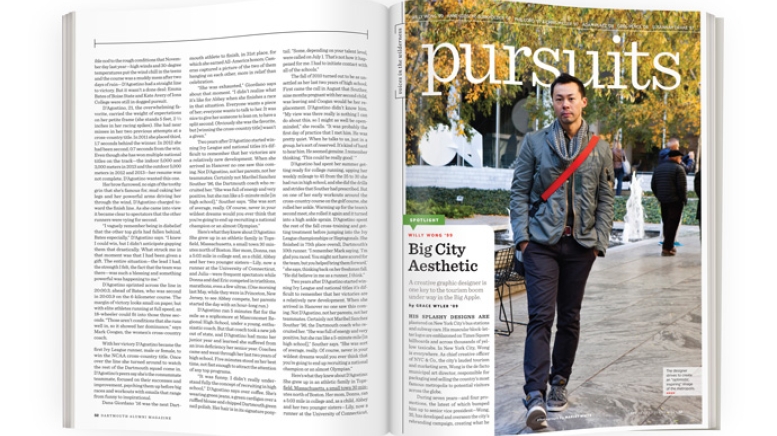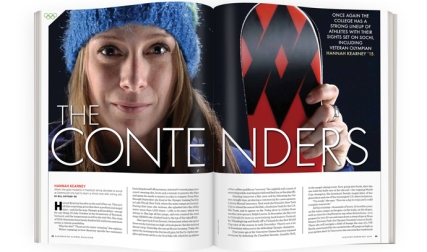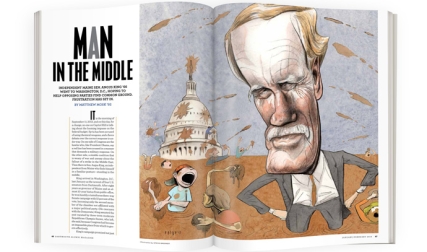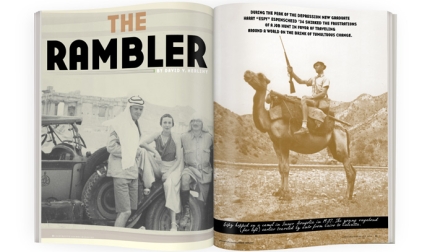Willy Wong ’99
Big City Aesthetic
His splashy designs are plastered on New York City’s bus stations and subway cars. His muscular block-letter logos are emblazoned on Times Square billboards and across thousands of yellow taxicabs. In New York City, Wong is everywhere. As chief creative officer of NYC & Co., the city’s lauded tourism and marketing arm, Wong is the de facto municipal art director, responsible for packaging and selling the country’s most famous metropolis to potential visitors across the globe.
During seven years—and four promotions, the latest of which bumped him up to senior vice president—Wong, 35, has developed and overseen the city’s rebranding campaign, creating what he describes as an “optimistic, inspiring and more functional” image of the city. The goal, Wong says, is to boost tourism as an economic driver for the city, and turn New York into a “global brand” that can compete with emerging travel destinations such as Dubai and Shanghai. “We want to remind people that New York is constantly changing,” Wong says, adding that visitors who delay a trip because “New York will always be there” risk missing out on the city’s constantly revolving stream of new attractions.
Since NYC & Co. was formed in 2006 as a merger of the city’s disparate marketing and events agencies, Wong’s team has far exceeded expectations. The economic impact of tourism on New York City has grown 42 percent in the last seven years and is projected to reach a record high of $70 billion in 2015. New York City is now the country’s biggest driver of tourism spending, as well as the largest overseas market, accounting for a full one-third of overseas travel to the United States. In 2011 the city surpassed its goal of 50 million visitors—and set a new target of 55 million by 2015. With an estimated 52.9 million people expected to have visited the city in 2013, NYC & Co. is well on its way to meeting that mark.
As chief creative officer, Wong has played an integral role in the tourism boom. His team designs billboards, events and ad campaigns—for everything from the upcoming Super Bowl XLVIII, jointly hosted by New York and New Jersey, to the city’s flashy tourism website, nycgo.com. His most visible work thus far has been the development of the now-ubiquitous block-lettered NYC logo that appears across the city’s various marketing platforms. “When we started the Statue of Liberty was everywhere, but I thought we could be more creative,” Wong says. “We made the purposeful decision to build a new set of images, or even just an attitude, that represented New York to convey an idea of urgency about visiting the city.”
Although Wong did not find his calling as a designer until after graduating from Dartmouth and earning an M.F.A. in graphic design from Yale, he says that lessons he learned from professors in Hanover about creative problem-solving and creating visual narratives inform his work for NYC & Co. Dartmouth animation professor David Ehrlich says Wong’s talent for design was apparent when he taught the student in the spring of 1997. “He combined tremendous creativity with perseverance and a really good personal style,” Ehrlich says. “He was charming and able to captivate the audience and organize things very well, which is exactly what he’s doing in New York.”
Wong, who immigrated to New York City from Hong Kong as a child, says that he draws his creative inspiration from urban cityscapes. “This idea of a skyline is something that I grew up with,” he says. “I love cities and I think that drives a lot of the aesthetic I have about urbanity.”
Grace Wyler is a freelance journalist based in New York City. Her work has appeared in Time, New York and Vice.
Anne (Gibson) Burkholder ’97
Bullish on Beef
“Two days after graduating from Dartmouth I put on my blue jeans and went to work at the cattle feedyard,” Burkholder says. “I started on the bottom with a scoop shovel and an hourly wage of $6.85.” Sixteen years later she owns the place—a 3,000-head cattle feedyard in Nebraska, where she works alongside her husband, Matt Burkholder ’94. She’s also among the leading voices in the national beef industry, determined to reassure a public unsettled by the feedlot horror stories in reports such as Fast Food Nation.
“I was a consumer for a lot of years before I really knew where my beef came from,” Burkholder says. “I think it’s very important that people have an understanding of what it takes to grow food and where it comes from.” Burkholder writes a blog, FeedyardFoodie.com, with the goal of making the process of growing U.S. beef—from farm to fork—more transparent. Burkholder also does volunteer work promoting animal welfare and food safety and is one of the leaders in the beef industry across the nation: She is a director of the Nebraska State Beef Council, sits on the Tyson Fresh Meats Animal Well-Being Committee and earned the 2009 Beef Quality Assurance Producer of the Year Award. “I’ve always been interested by how animals think, and in particular cattle and other prey animals really interest me,” says Burkholder, whose A.B. in psychology comes in handy on the farm. “I’m fascinated by how their brains work.”
—Rianna P. Starheim ’14
Phil Lord ’97 & Chris Miller ’97
Clicking Together
With two movies coming out in 2014, The Lego Movie and 22 Jump Street, as well as two Fox TV pilot deals for their Lord Miller production company, it’s clear that this pair may achieve Lord’s goal of “trying to squeeze in world domination sometime before Christmas.”
Lord and Miller got their start in Hollywood by creating the animated MTV series Clone High and writing for the sitcom How I Met Your Mother. “You’d think learning about Cold War policy wouldn’t be too helpful on a sitcom, and you’d be right—most of the time,” says Miller, a studio art and government double major. They’ve focused on films in recent years—co-writing and directing 21 Jump Street and Cloudy With a Chance of Meatballs and co-producing its sequel. The Lego Movie (“a movie about totalitarianism for kids,” Lord says) marks their return to animation, and 22 Jump Street, Lord says, “has the most authentic beer pong playing ever committed to film.” The Dartmouth beginnings of their partnership were not rosy. “Chris and I shared a studio in Clement that smelled like melted crayons, had no air conditioning and was across the hall from career services,” says Lord, an art history major. “Do you know how humiliating it was to watch every member of my class pass by our door dressed in a fancy suit on their way to lucrative careers while we nursed tendonitis drawing cartoons in our underwear? Everyone thought we were lunatics.”
—Bonnie Barber
Adam Platz ’08
Physical Physics
In 1922 Russian astrophysicist Alexander Friedmann arrived at a model that invoked Einstein’s theory of general relativity to describe an expanding universe. Little did he know that the resulting “Friedmann equation” would end up adorning the skin of much of the right abdomen of a young Dartmouth grad. “My senior seminar in astrophysics focused in part on this equation,” says Platz. “I found it elegant and beautiful, my own little God equation.”
He immediately wanted to be tattooed with the formula, but waited five years before taking the plunge last spring. It took a tattoo artist more than three hours to render the equation in black ink. And yes, it hurt. “My rib meat is a little tender,” says Platz, who has six other tattoos and works as an events manager at a small brewery in Maine. He says the artwork is more than decorative: “I want things on my body that reflect my belief system,” he says. “Astronomy and science, numbers and physics, those are my religion.”
He notes Friedmann’s work explains the origins of our expanding universe. “If you push ‘go’ on this equation, you can see the past, present and future of our universe and how we as human beings fit into that picture,” says Platz. A rare astronomy major with no intention of pursuing an advanced degree or career in the field, he double-checked with some Cal Tech friends to make sure he had the correct reference for the tattoo artist. “My biggest fear,” he admits, “is that I’m back on the Green 10 years from now, playing football with my shirt off, and my seminar prof sees my tattoo and says, ‘Oh no, you got it wrong!’ ”
—Sean Plottner
Greg Pence ’06
Drawing Attention
Pence blends his artistic talents with a passion for social justice on the Korean peninsula. Born in Chicago and raised on a steady diet of Calvin and Hobbesand Peanuts, Pence now depicts the harsh political climate in North Korea as an editorial cartoonist for the Seoul-based Daily NK. Pence moved to South Korea in 2008, first to teach English, then to study Korean nationalism as a 2010 Fulbright fellow before landing his job with the online news service that promotes the free spread of information across Korea. “Scribbling allowed me to build trust with former student revolutionaries and North Korean defectors,” he says. He also recently spearheaded a crowd-funding campaign to raise $10,000 to support Daily NK. Pence’s diverse roles carry one common thread: cartooning. “Drawing is a little bit like praying for me, like meditating,” he says. “It adds a lot of meaning to whatever it is I am doing.” The fundraising campaign was no exception: Pence thanked major donors with personal caricatures.
Pence is now turning his attention to Sandbrush, a nonprofit he founded to assist under-resourced artists in producing culturally significant works that promote democratic rights and human rights. “Art is incredibly important,” he says. “It defines and transforms and it reveals and it reflects and it prophesizes. There’s a magic to art that cannot be defined or reamed away.”
—Rianna P. Starheim ’14
Susannah Drake ’87
Greened Up
How do you transform Brooklyn’s Gowanus Canal, an Environmental Protection Agency Superfund site, into a beautiful public space while simultaneously remedying the street runoff and sewage overflow that pollute the 1.8-mile waterway? You invent a sponge park—“a park that’s going to absorb a lot of water,” says Drake, a landscape architect. Her award-winning design incorporates sidewalk bio-swales that will divert up to 4,500 cubic feet of storm water and runoff into a bio-retention basin, she says. “Plants and engineered soil will help to filter that [runoff] water and in some cases break down the biological toxins before the water can enter the canal,” says Drake. “And some of the plants—hardy roses, irises, switchgrass and clover—were chosen because they can help to remediate some of the heavy metals and the chemical toxins in that water.”
She first started working on the 5-acre master plan with community groups in 2007. Construction on a small pilot section on Second Street will start this spring and will take about six months. Drake raised the $1.5 million to cover the pilot project through community and state grants. More sponge parks, a term that her Brooklyn-based firm dlandstudio has patented, may be on the way. Drake, who has made the components easy to reproduce, says 772 cities nationwide are burdened with combined sewer systems like that in New York City, where storm water runoff and sewage combine during rainstorms and are released into waterways. “Green infrastructure systems, or working landscapes, are becoming more common,” she says.
“In a way I feel like we’re going back to Olmsted now,” she says, referring to Central Park designer Frederick Law Olmsted, “recognizing that the landscape can have tremendous power in the city to help us with a lot of the infrastructure systems.”
—Bonnie Barber




